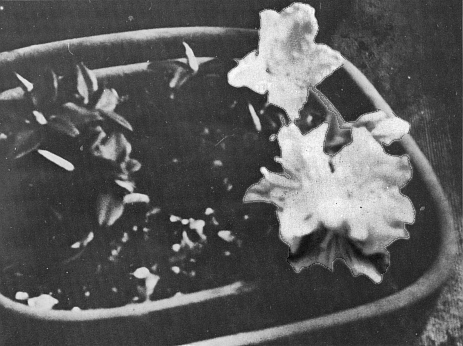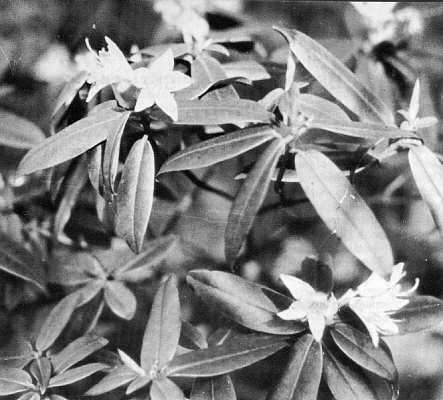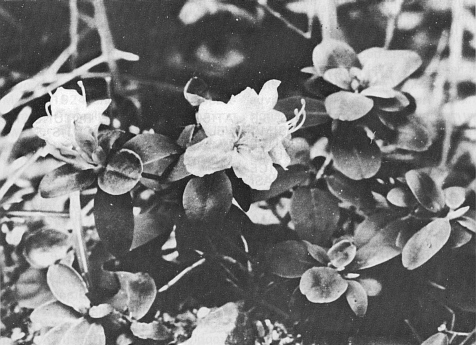The Rhododendron Keiskei Affiliation
Collingwood Ingram, Beneden, England

|
|
R. keiskei
from the central part of the main island of Honshu.
This plant is at present about 45 years old. It has a loose habited growth up to about six feet in height. Photo from Collingwood Ingram |
In the Rhododendron and Camellia Year Book for 1971 I published a short paper entitled Notes on the Keiskei Complex in the Triflorum Series of Rhododendron species. At that time I possessed living plants belonging to that affiliation not only from the island of Honshu but I also had a number from the islands of Kyushu and Yakushima. These constituted enough material to convince me that within that affiliation there certainly existed by any taxonomic standards more than one distinct species.
Since the publication of that paper thanks to the generosity of Mr. Warren Berg, Dr. Tor Nitzelius and Mr. K. Wada my collection of plants belonging to that group of rhododendrons has been greatly enriched. By the acquisition of their gifts I now have living specimens from well nigh the whole of that group's range in Japan and this has made me more than ever convinced of the need to recognize and classify some of its more distinctive forms.
The Japanese botanist, Hiroshi Hara in the 1948 issue of the R. H. S. Rhododendron Year Book has (in a slightly paraphrased version) this to say about
Rhododendron keiskei
. "It is endemic to Japan on the hills, on the rocks and in the valleys; sometimes even on trees. It ranges from the Kwanto district in Central Honshu South Westwards through Shikoku to Kyushu" (and beyond to Yakushima.)
With such a very extensive range and such an amazing diversity of habitat it would indeed have been surprising if evolution had not over the years created within that rhododendron's affiliation at least one or two distinct species. Surely no experienced botanist could reasonably expect a plant which has to endure at an elevation of over 5000 feet, a score or more typhoons every year and at the same time submit to an annual rainfall of nearly four hundred inches, to remain specifically identical with a plant which has always enjoyed the shelter of a sub-tropical forest?

|
|
R. kuromiensis
from Mt. Kuromi (5000 feet) on Yakushima.
Note disproportionately large flowers. Photo from Collingwood Ingram |
The former of the two plants referred to above is a strikingly distinct rhododendron which I propose to name
Rhododendron kuromiensis
after the mountain in Yakushima from which it comes. To enable it to survive at that great height the devastating effects of those typhoons, it has acquired very small leathery leaves and a completely procumbent, semi-stoloniferous mat-forming habit, while to mitigate the effects of the excessive moisture from the unusually heavy rainfall, it obtains the necessary drainage by residing on the tops of boulders - all of which characters are totally unlike any of those of my plant of
R. keiskei
from the island of Honshu or of those of any herbarium specimens of the species emanating from that island. In short, within one and the same genus it would be hard to find two more widely dissimilar plants.
One of the most striking differences between
R. kuromiensis
and the typical
R. keiskei
is in the ratio between the sizes of their flowers and foliage. For instance compared with its foliage the flowers of
R. kuromiensis
are disproportionately large being about two or three times that of its leaves, whereas those of
R. keiskei
are, if anything, smaller than its foliage.
In the paper I wrote for the 1971 Year Book I described and named two rhododendrons which I believed were new to science.
International Dendrological Society Year Book 1972.
One of these I called
Rhododendron trichocalyx
. Although at the time I had good reason to suppose my specimen had been imported from Japan by the late Miss Davenport-Jones with other nursery plants I have now learnt that this was probably not the case. For that and other reasons I have come to the conclusion that my
R. trichocalyx
must be regarded as of hybrid origin.
There is no such ambiguity about the provenance and validity of the other supposedly new species which I named
Rhododendron laticostum
because of its unusually conspicuous rhachis. I now know that my type specimen had been collected by an employee of Mr. Wada on the upper slopes of a mountain in central Yakushima.

|
|
R. laticostum
var
lithophilum
from the Kirishima Mountain,
(4500 feet) Kyushu. Photo by T. Hardin |
Writing of his botanical exploration of Mount Miyanoura in that island Mr. Robert de Belder gives us an interesting clue as to the locale of my new species. He tells us that at lower altitudes R. keiskei is a shrub 1-2 m. high, but at higher elevations up to 1700 m (5150 feet) it is represented by a much more compact form. He is here clearly referring to my
R. laticostum
, the typical form of which is characterized by its low stature and by its densely-branched, compact form, and also by the size, shape and texture of its paler-colored foliage. Instead of being lanceolate, as in
R. keiskei
, its leaves are broadly oblong or broadly ovate with a conspicuous greenish-white midrib which widens notably before merging into a very short rigid petiole. Their average length is 4 cm., whereas those of Miquel's type of
R. keiskei
measure up to 7 cm.
The plants given to me by Dr. Tor Nitzelius were all seedlings raised from seed he had collected at altitudes of about 4500 ft. in the Kirishima mountains of Kyushu. These have proved of great interest for in the first few years of their life they have a distinctive juvenile foliage. Their leaves are then so broadly ovate that they were almost, sometimes quite, orbicular in shape, and even at that early age they will usually produce relatively large rotate flowers. When the plants become more mature their foliage lengthens somewhat and their leaves then become more oblong in shape but still have blunt or rounded tips. As one descends to lower elevations I understand these Kirishima rhododendrons tend to merge into my
R. laticostum
so, although in their juvenile phase they are so strikingly distinct, I intend to classify them as varieties of that species and as such am calling them
Rhododendron laticostum
var.
lithophilum
.
Owhi in his Flora of Japan mentions two varieties of
R. keiskei
which have been described by different Japanese botanists. One of these has been named
Rhododendron keiskei
var.
hypoglaucum
by Suto and Suzuki. Although its habitat is in Honshu, and therefore a very long way from Yakushima, the home of my
R. laticostum
, it may nevertheless prove to be somewhat similar to that plant. The other variety (which also comes from Honshu) is
R. keiskei
var.
cordifolia
. But as Owhi says its leaves are lanceolate and measure up to 8 cm. in length it cannot be closely allied to
R. laticostum
.
RHODODENDRON KUROMIENSIS
FRUTEX PUMILA PROCUMBENS, 5-6 cm ALTUS. RAMULl BREVISSIMI, SAEPE HORTIZONTALES, PALLIDE BRUNNEI, MINUTISSIME PUBESCENTES. FOLlA OVATA, APICE ACUTA, SAEPE MUCRONATA, BASI IN PETIOLUM CUNEATIM ANGUSTATA, 2cm LONGA, 1 cm LATA, CORIACEA, SUPRA MINUTE RETICULATA SECUS COSTUM MINUTE PUBESCENTIA, SUBTUS GLABRA SED SQUAMIS NUMEROSIS IN VIVO ALBIS IN SECCO BRUNNEIS PUNCTATA, PETIOLUS c.4 mm LONGUS, CRASSUS. lNFLORESCENTlA TERMINALIS, 3-4 FLORA, FLORIBUS ERECTIS; PEDICELLI c.8 MM LONGI. SEPALA BREVISSIMA. CORELLA PALLIDA FLAVA, LATA CAMPANULATA, FERE ROTATA c.4.3 cm DIAMETRO, LABIS IRREGULARITER EMARGINATIS, PLERUMQUE ROTUNDATIS VEL OBTUSIS HAUD ACUTIS. STAMINA EXSERTA. CAPSULA DENSE LEPIDOTA. HAB. MONS KUROMI, AD 5508 PED. YAKUSHIMA CENTRALIS, JAPAN AUSTRALIS. (WARREN BERG) HOLOTYPUS SPECIMEN IN HERB. MUS. BRIT.
A very dwarf procumbent shrublet up to 5-6 cm. in height. Branches very short and often produced horizontally. Apparently semi-stoloniferous. Leaves strongly coriaceous: distinctly ovate in shape tapering to a fairly acute often mucronated apex. They measure about
2 cm. long, by about 1 cm. at their widest point. Upper surface impressed with a minute reticulated pattern. Under surface dotted with small white glandular scales. Petiole very short and rigid 4 mm. long. Flowers pale yellow in terminal clusters of 3-4 blooms. Corolla held erect; very widely open-campanulate, almost rotate, about 4.3 cm. across. Segments irregularly emarginate and mostly round- or blunt-tipped (not acute) Calyx rudimentary. Stamens exserted and widely spreading. Capsule densely lepidote.
Habitat. On boulders near the summit of Mount Kuromi (5508 ft.) Central Yakushima, Japan. The type is preserved in the Herbarium of the Natural History branch of the British Museum.